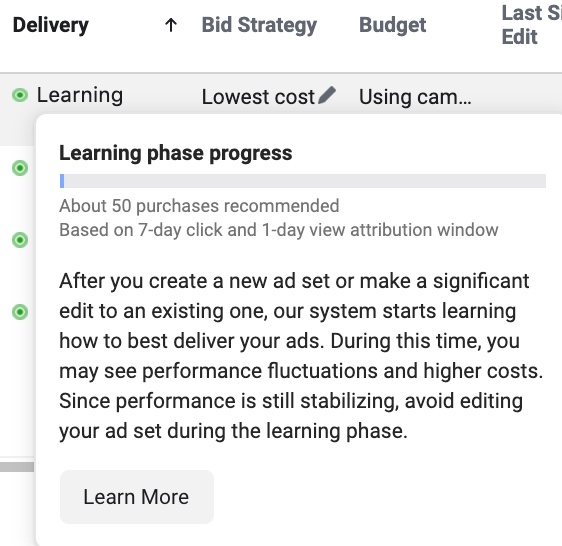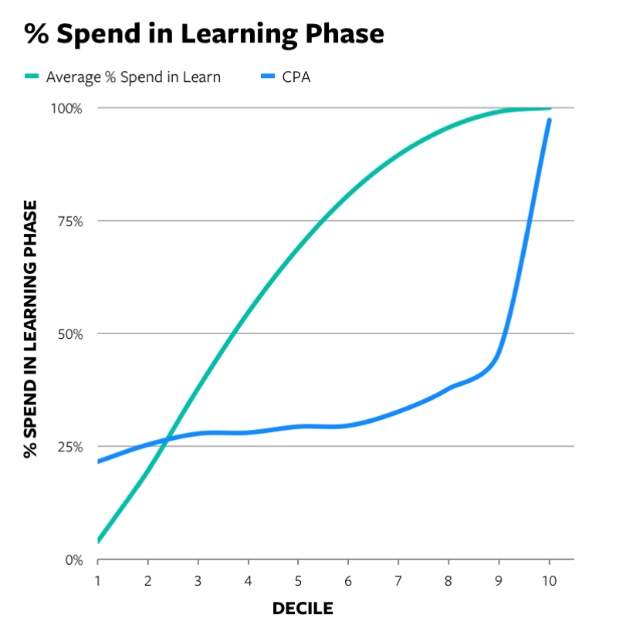Facebook uses machine learning to gain insights on the best users and placements to show an ad. With each impression, Facebook’s delivery system gets slightly better at optimizing ad performance.
In late 2017, Facebook unveiled the learning phase. This ad set-level metric gives advertisers a pulse check on any algorithmic optimizations occurring behind the scenes each time an ad is served.
If you’ve pushed an ad set live between the rollout of this delivery insight and the present day, you’ve likely seen this message in your Ads Manager dashboard.
In the Delivery column, Facebook indicates which ad sets are actively gathering learnings and lets you monitor progress as your ads get closer to reaching the recommended 50 conversion events.

Regardless of your campaign objective, Facebook relies on the learning phase to gather as much data as it can to figure out the most effective way to deliver an ad set. The delivery system is looking for around 50 conversion events in a seven-day window to gather the insights it needs to stabilize performance, and ad sets will remain in the learning phase until the necessary number of conversion events have been reached.
During that time, though, you can expect your performance to fluctuate. Ad sets in the learning phase generally see higher CPAs than stabilized ad sets, so it’s important to wait for your ad sets to exit the learning phase before jumping to any conclusions about the performance of your campaigns.

According to Facebook, “advertisers with ~20% of spend in the learning phase (2nd decile) see 17% more conversions and 15% lower CPA than advertisers with ~80% of spend in the learning phase (6th decile).”
With that in mind, your ad sets would ideally spend the least amount of time necessary in the learning phase before performance stabilizes. Sometimes though, that’s not the case. If a week has gone by and your ad set still hasn’t exited the learning phase, you’ll see the “Learning Limited” insight in the Delivery column.
Learning Limited
The Learning Limited status indicates that your ads could not generate the recommended number of conversions during the initial seven-day learning phase.

As a result, the Facebook delivery system won’t be able to optimize performance, meaning your ads won’t see full results or may encounter issues spending your budget in its entirety.
If your ads seem to be stuck between Learning and Learning Limited status, you’re probably wondering what gives. If that’s the case, it’s important to step back and make sure you’re not inhibiting Facebook during the learning phase. This means you should avoid:
- Budgets that skew too large or too small. You need enough ad spend to get you the recommended 50 conversions, but an inflated budget can impact the way the delivery system optimizes.
- Edits to your ad set or ads.
- High ad volumes. This can unintentionally force your ad sets and ads into competition, resulting in fewer learnings for each ad set and ad.
If you’re obeying Facebook best practices and still seeing “Learning Limited” in the Delivery column within Ads Manager, try troubleshooting by testing some of the strategies below.
Mitigate Audience Overlap
Without distinct targeting parameters, your ad sets may be unintentionally overlapping. Not only can this lead to higher costs, but it plays a big role in the delivery of your ads, too. When audiences are used across ad sets or share similarities, Facebook prioritizes the top performer to mitigate competition within a single account. This means the other ad sets won’t fully deliver; as a result, they may be forced into Learning Limited status.
To combat this, combine ad sets with relevant targeting to minimize overlap. You can get more insight into any potential crossover with the “Show Audience Overlap” setting within the Audience tab of the Assets section.

Consolidate Ad Sets
If remedying targeting overlap still leaves you with an excessive number of ad sets, Facebook recommends account simplification through the consolidation of ad sets. When too many ad sets are live at once, the ads within them are served less often, resulting in more time in the learning phase.
Advertisers can work around this by consolidating relevant ad sets. For example, using automatic placements eliminates the need to break out ad sets by placement; opting for multiple languages in a single ad set means you don’t need to create a unique ad set for a single language.
Expand Your Targeting
If your audience is too small to begin with, there’s a high likelihood that’s a factor that’s limiting your ad sets’ ability to win auctions.
Audience definition directly impacts the effectiveness of your targeting, especially for organizations that sell niche products or services. Keeping your budget in mind, make targeting adjustments that give your audience pool more breadth.
By expanding your targeting, you’re giving Facebook a wider pool to more accurately search for the users that are most likely to take the desired action from your ads. Make sure you’re keeping audiences sizes consistent across ad sets, though. Campaign Budget Optimization will typically prioritize the delivery of the ad set with the largest audience, which could unintentionally impact the learning phase of your other ad sets.

Readjust Your Optimization Event
One of the most obvious factors that forces ad sets into Learning Limited is a lack of conversion events. Without hitting the desired 50 events in a weeklong span, Facebook is unable to gather the learnings it needs to stabilize delivery effectively. If that’s the case, consider readjusting your optimization event.
For example, if you’re optimizing for purchases but seeing fewer than 50 per week, try optimizing for a more common conversion event. An add-to-cart optimization may be slightly higher up in the funnel, but it likely occurs more frequently than a purchase. And, since the end goal is the same, it’s more likely to get your ad set out of the learning phase and avoid Learning Limited status altogether.
Although the learning phase can seem like a nuisance, the findings gathered by Facebook’s system during this time period are crucial to the delivery of your ads. Working with Facebook’s system ensures better results and better insights into your strategy moving forward.










I always have a question in mind, in order to optimize for a more common event, example view content, after reaching 50 events what is the next step?
Convert it to ATC using the same adset? Or create a whole new adset. Both will allows them to restart the learning phrase am i right?
And if the adset were restarted when we shifted to the next event funnel, does it defeat the purpose?
Or the pixel will recognize all the learning as long as we reached 50 events, the data will be stored in the pixel for future?
Hi Vincent! Thanks for the comment. You’re correct that both scenarios, either making a significant change to your ad set or creating a new one, would reset the learning phase. Thankfully, though, your Facebook Pixel will use data gathered over time to inform delivery optimizations in the future. The more an ad is shown, the better Facebook’s delivery system becomes at serving ads. So while each ad set will need to reach the minimum number of events to exit the learning phase, in theory, it will become easier for the algorithm to optimize delivery over time.
I hope this helps! Good luck.